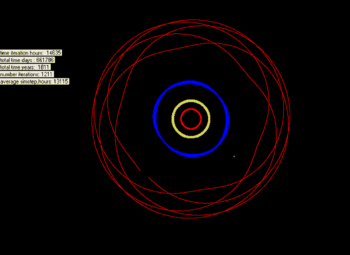(182294) 2001 KU76
| Discovery[1] | |
|---|---|
| Discovered by | Buie, M. W. |
| Discovery date | 2001-05-24 |
| Designations | |
| MPC designation | (182294) 2001 KU76 |
| Minor planet category |
Trans-Neptunian object 6:11 resonance[2][3] |
| Orbital characteristics[1] | |
| Epoch November 30, 2008 | |
| Aphelion | 52.721 AU (Q) |
| Perihelion | 37.664 AU (q) |
| Semi-major axis | 45.193 AU (a) |
| Eccentricity | 0.16658 |
| Orbital period | 303.82 yr |
| Mean anomaly | 345.16° (M) |
| Inclination | 10.647 ° |
| Longitude of ascending node | 45.016° |
| Argument of perihelion | 205.62° |
| Physical characteristics | |
| Dimensions | 211 km (assumed)[4] |
| Albedo | 0.09 (assumed) |
| Absolute magnitude (H) | 6.5[1] |
|
| |
(182294) 2001 KU76, provisionally known as 2001 KU76, is a trans-Neptunian object (TNO) that has a 6:11 resonance with Neptune.[2] This is the same resonance that dwarf planet Makemake is either near or in.[5]
It will come to perihelion in 2021.[1]
Assuming a generic TNO albedo of 0.09, it is about 211 km in diameter.[4] The assumed diameter of this object makes it a possible dwarf planet.[6]
Resonance
Simulations by Lykawka in 2007 show that (182294) 2001 KU76 is librating in the 11:6 resonance with Neptune.[2][3] This is the same resonance that dwarf planet Makemake is either near or in.[5] Both objects have a semi-major axis of 45 AU and an orbital period of about 302 years.
It has been observed 29 times over 6 years and has an orbit quality code of 4.[1]

References
- ↑ 1.0 1.1 1.2 1.3 1.4 "JPL Small-Body Database Browser: 182294 (2001 KU76)". 2008-05-03 last obs. Retrieved 2009-02-06.
- ↑ 2.0 2.1 2.2 Lykawka, Patryk Sofia; Mukai, Tadashi (July 2007). "Dynamical classification of trans-neptunian objects: Probing their origin, evolution, and interrelation". Icarus 189 (1): 213–232. Bibcode:2007Icar..189..213L. doi:10.1016/j.icarus.2007.01.001.
- ↑ 3.0 3.1 Buie, Marc W. (2008-05-03 using 29 observations). "Orbit Fit and Astrometric record for 182294". SwRI (Space Science Department). Retrieved 2009-02-06.
- ↑ 4.0 4.1 Johnston, Wm. Robert (22 August 2008). "List of Known Trans-Neptunian Objects". Johnston's Archive. Retrieved 2009-02-06.
- ↑ 5.0 5.1 Tony Dunn (Author of Gravity Simulator). "Possible resonances of Eris (2003 UB313) and Makemake (2005 FY9)". Gravity Simulator. Retrieved 2009-02-06.
- ↑ Brown, Michael E.. "How many dwarf planets are there in the outer solar system? (updates daily)". California Institute of Technology. Retrieved 2012-09-04.
External links
- Orbital simulation from JPL (Java) / Horizons Ephemeris
| ||||||||||||||||||||||
| ||||||||